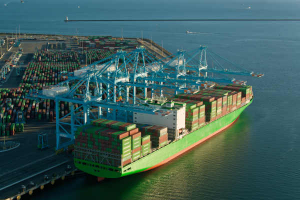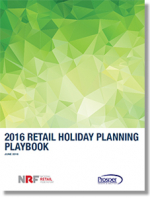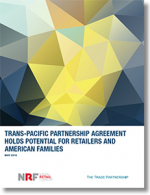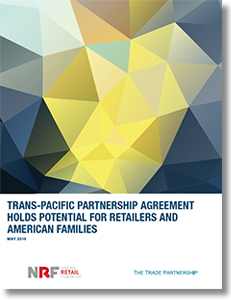Trans-Pacific Partnership Agreement Holds Potential for Retailers and American Families
This report, prepared by The Trade Partnership for NRF, describes how the TPP will have a significant positive impact on American families, workers and the retailers who seek to provide them with a wide range of goods at affordable prices.
The Trans-Pacific Partnership is a trade agreement recently negotiated by the United States with 11 countries in the Asia-Pacific region.
It establishes strong rules affecting trade between the United States and Australia, Brunei, Canada, Chile, Japan, Malaysia, Mexico, New Zealand, Peru, Singapore and Vietnam.
These countries currently account for 39 percent of U.S. goods and services exports and 35 percent of U.S. goods and services imports.
The United States already has free trade agreements with six TPP countries (Australia, Canada, Chile, Mexico, Peru and Singapore), which are already fully in effect or nearly so.
The TPP potential really lies in the addition of five new FTA partners: Japan, Malaysia, New Zealand, Vietnam and Brunei.
U.S. retailers are the primary direct link between American families, workers and producers in the TPP countries. Retailers buy apparel, footwear, consumer electronics, food products and many other consumer goods from suppliers in TPP countries.
Some U.S. retailers maintain stores in TPP countries that they supply with goods purchased locally but also from U.S. manufacturers. There are close to 7 million trade-related retail jobs.
The TPP will affect retailers and their customers in several ways:
- by getting rid of unnecessary and sometimes high costs of doing business with and in TPP countries,
- by providing assurance (and reassurance) that foreign suppliers produce goods that measure up to U.S. consumer protection, labor and environmental standards,
- and by helping to grow the U.S. economy in general.
But the TPP can only deliver these benefits to U.S. retailers and consumers if Congress approves legislation implementing it.
This report, prepared by The Trade Partnership for NRF, describes how the TPP will have a significant positive impact on American families, workers and the retailers who seek to provide them with a wide range of goods at affordable prices.
It will lower costs across global supply chains in the TPP region, and those lower costs will be reflected in U.S. price tags and improved product mixes. Families will benefit from greater spending power, both from lower prices and from higher wages.
What’s Related




Favorites





